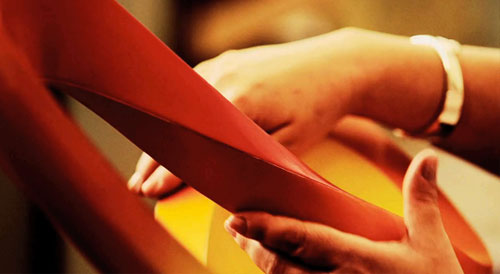Affectionately nicknamed “the Fuji,” the Atari logo still persists as a lasting part of popular culture.

While other logo designs of the era — Carolyn Davidson’s Nike “swoosh” or the Apple logo created at Regis McKenna — have spawned mythologies and lengthy design criticism, the origins of the Atari logo are still wrapped up in some mystery, adding to the mystique of its designer, George Opperman, and the iconic mark itself.
The facts we do know are here: George Opperman designed the logo for his clients at Atari, while working at his own agency, Opperman-Harrington Inc. Atari creative director George Faraco and co-founder Nolan Bushnell were involved in the creative direction and final selection as well. But Opperman’s creative process and actual intent are much less clear.

In a 1983 interview with Video Games, Opperman explained the origins of the logo this way: “Symbols are just visual nicknames that combine first letters and interpretive design elements. I kept trying to stylize the ‘A,’ then I looked at PONG, their big game at the time. PONG had a center line and a force (the ball) that kept hitting its center from either side. I thought that (force) would bend the center outward. And that’s what I designed.”
This explanation was intended to solidify Opperman’s intent behind the logo, but not all parties agree with the “official story.” In other interviews, Faraco insisted the logo had no such concept behind it, and suggested that Opperman imputed this explanation after the fact. “That’s all utter bullshit,” Faraco said. “It’s just a design. There was none of that linguistic, storytelling crap. That’s somebody’s invention. He gave me a bunch of doodles, so I said, ‘Use this one,’ and that was it.”

For his part, Bushnell believes that Opperman purposefully offered multiple, conflicting origin stories for the logo — like the idea that it represented a Japanese character, or its similarity to the famous Mount Fuji. Regardless of intent, the final version of Opperman’s logo made its public debut in promotional materials and the cabinet for the arcade game Space Race in 1973.
Bushnell recounted his own creative brief for the Atari logo: “I said, ‘It has to be very simple. You have to be able to recognize it from one hundred feet away if it’s on an 8×10 piece of paper, and it has to be easily reproduced on hats, t-shirts, or what have you. It can’t have a lot of tiny lines — it has to be bold.’ I loved it from the day I saw it. It was like ‘That’s it!’ There was never any hesitation.”
—
If you fancy some childhood nostalgia (the 2600 was the first console I played), Art of Atari is available from Amazon.com and Amazon.co.uk.






Comments
David, thanks for this post — especially, I pen down Atari logo’s creative brief recounted by Bushnell — very useful.
Howbeit, I can’t side with Faraco insisting that “the logo had no such concept behind it, and suggested that Opperman imputed this explanation after the fact.” [Unless Faraco had asked Opperman at the time of presentation about what had inspired Opperman to create the Atari logo, and Opperman couldn’t provide him any tangible insight when he asked, OR as usual, Opperman never mentioned a thing about what had inspired him to create the Atari logo, then, only then can we rely on Atari’s side of the story, too.]
I think it’s unprofessional on Atari’s part for uttering these words: “That’s all utter bullshit,” Faraco said. “It’s just a design.” [Of course, it’s a design — I think that’s exactly what it is, a design]
Every logo has its own inspiration trigger, and the designer is the one to tell that side of the story.
Completely agree, and the real bullshit part is that a Creative Director would dismiss another artist’s work as ‘doodles’. This Faraco sounds like a real asshole.
I agree with you, Simon, and I find the remark “just a design” is underestimating what design even means.
Most designers just show the visual and don’t discuss the inspiration, so clients are left in the dark about the creative process behind it – but in that case, they’re not the right people to ask about the creative process. They don’t know.
I’d take Opperman’s word for it, he’s the one that did the “doodles”.
And this might serve as a lesson for us to include the “behind the scenes” in our design proposals and share what has inspired us with our clients. They might respect the final logo more.
I think it comes down to which version you’d be happier with. I too would want to believe a grander (or at least more traditional) origin story for a logo as memorable and well-loved as the Atari logo.
To be fair, the version described by Faraco is not so hard to believe. The way Faraco attacks and belittles Opperman’s version makes him sound like the kind of (un)professional quick to approve a logo from preliminary sketches without first hearing the rhyme and reason/story behind it.
The more magical-seeming the origin story, the easier it is for me to connect with and grow to love a brand. I think you can imagine whose version I am siding with :)
Wonderful read, David!
Just like ‘it’s the sizzle that sells the steak’, ‘it’s the talk that sells the design’. I suspect that Opperman may be a little guilty of embellishment for marketing his craft. He caught a big fish and it is possible the fish gets bigger every time he told the story. A great logo, yes, but I didn’t find extensive examples of his other logos. What would this article look like if Paul Rand designed the logo? Actually, the story wouldn’t even be here.
In defense of Farco, this is an article that takes material out of context and to call him an asshole or to side with Opperman after reading a biased piece seems naive and short sighted to me. Hello – He was the creative director of Atari! I’m not for or against – just undecided or inconclusive based on limited information. Many times it is the experience with a product that makes a logo great. I believe if we examined the greater problem, we would find that Opperman’s impact on the Atari brand and success had minuscule impact in comparison to Farco and Bushnell. These guys were busy making thousands of decisions and this is one of them. Most logos come down to what the founders’ wives or kids like anyway, but nobody will tell you that when we write about it 40 years from now.
Clean, visible and clear, that’s the way. Yes the branding and copy will be key but this logo is a good example of a quality one. It can be used anywhere and very easy to be seen at any size. It works on any UI / UX interface. I enjoyed this post, great insight.
Many myths behind the logo, but it’s iconic and unforgettable! Very cool article.
Amiga forever!
The Atari logo was first used on the 1972 Pong flyer and one or two other 1972 flyers. So Spare Race was not the first.
In that list of logos, I suspect #4 from the left was intended as a strawman since it’s nearly identical to the Sperry Univac logo.
Was it ever called Fuji Boink or Bunk or something similar? 🤔 For some reason, Fuji Boink comes to mind from that era, 83-86.
FujiBoink! was a demo made for the Atari 8-bit and ST machines around 1986 as kind of a reaction to the infamous Amiga Boing Ball demo. Just to show that “Atari can do it too.” :-)
https://youtu.be/LhrRJMm35fg
This is what the Atari logo means, are you able to see it?
Esto es lo que significa el logo de Atari, eres capaz de verlo?
[images no longer available]
Stumbled across this on a nostalgia trip.
I’d like to think Opperman’s account of Pong as a reference holds weight – he was probably just recounting his personal internal dialogue. The steps and thought processes you go through when designing a logo.